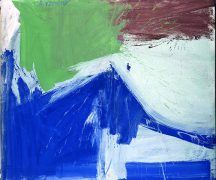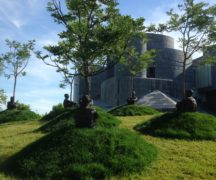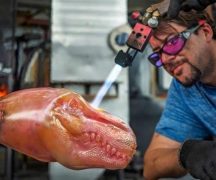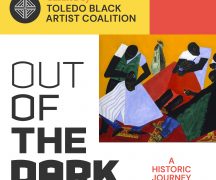By DAVID DUPONT
BG Independent News
For the next six months “Paula” will preside at the Monroe Street entrance of the Toledo Museum of Art.
The sculpted head stands 22 feet tall, weighs 35,000 pounds, and if you listen closely enough she may whisper to you.
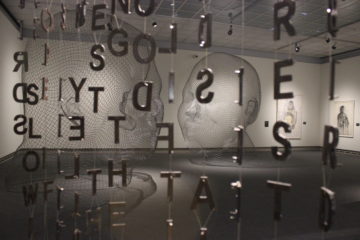
Looking through “Silent Rain” at “Awilda and Irma”
Jaume Plensa’s work needs room to speak to viewers. Space for viewers to stroll around and quietly commune with the large structures. The human forms reflect back to viewers something, maybe secrets, about themselves.
The Toledo Museum of Art has given the Plensa’s art the room it needs both inside in the Levis Gallery and spread across the museum’s 36-acre campus. The Spanish artist’s work has already found a home here.
At a recent press preview, the museum’s associate director Amy Gilman said that when Plensa’s “Spiegel (Mirror)” was installed at the intersection of Collingwood and Monroe a few years ago, museum officials weren’t sure what the response would be. “We didn’t know what would happen when we put something at such a prominent intersection of the museum and the city. … The public doesn’t always like the public part of public sculpture.”
Even before the installation was complete, she said, “it became beloved. It became a touchstone.”
Since then people have picnicked, played, and wed near the sculpture. So when the opportunity to bring this show, which was organized by the Cheekwood Botanical Garden and Museum of Art in Nashville, to Toledo, “we didn’t hesitate.”
The installation of “Spiegel” also made people realize how far the museum’s campus stretched.
Gilman said the museum wants to extend its programs into that 36 acres, and Plensa’s “Human Landscape” is the ideal vehicle to further that mission.
So through Nov. 6, “Spiegel” will be joined by “Paula” and five more monumental Plensa sculptures spread around the grounds. The museum has a summer’s worth of outdoor activities planned, starting with the Community Block party today (Saturday, June 18) from 6 to 10 p.m. and continuing with outdoor poetry readings, flashlight tours of the sculptures, poetry readings, concerts, and a Play Space for children.
“One of the things we’re really working on here is activating the entire campus,” Gilman said.
The intention is to continue to engage the same caliber of artists as the museum has always exhibited “and work with them in unique and wonderful ways.”
The installation of “Human Landscape” was a collaborative effort, explained Claude Fixler, exhibit designer for the museum.
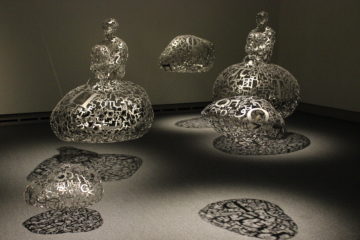
“Talking Continents” by Jaume Plensa
The artist himself visited to consult on the placement of the outside sculptures, as he had when Spiegel was installed. And his representatives were on hand when the 18 works on paper and sculptural installations were set up in the Levis Gallery “to make sure Plensa’s vision is carried out in placement and lighting,” Fixler said.
The design is meant to give the experience a sense of rhythm and carry the viewer through the exhibit and “giving the larger pieces more space so you have more time to be with them and contemplate them.” he said.
“It is a very contemplative environment,” Gilman said. “It works to encourage you to have that interaction with them. It’s a dialogue not only with the work but with yourself.”
Lighting sets the mood. The Levis gallery is dimly lit, except for the illumination of the objects. “His work responds so dramatically to light we really wanted that to be the focus,” Gilman said.
Central to the exhibit is the dream-like “Silent Rain,” that rare museum piece visitors can touch. The series of screens is made up of suspended letters. They spell out lines of poetry. This was inspired by Plensa’s visit with his mother to a grocery store that had a metallic screen between sections of the store, Gilman said. When someone walks through Plensa’s metallic poetry, it rings out with a soft jangling.
The lighting is crucial in another way. For “Talking Continents,” a series of objects hung from the ceiling, the lace-like shadows are as important as the objects themselves, Gilman said.
Nearby are three heads hung like gargoyles from the walls. They represent the adage “See No Evil, Hear No Evil, Speak No Evil.” Each has words imprinted on them, but the viewer must get under them to see, and only then, Gilman said, do you realize how large they are.
One figure has the words “anxiety” and “stress” cover the eyes, and “insomnia” covers the mouth.”
As mythic as the figures seem, evoking the ancient heads on the Easter Islands, the people they portray are ordinary folks. The visitor is greeted at each entrance of the gallery by Rui Rui, the artist’s son’s fiancée, Fixler said. “Awilda and Irma,” the paired translucent heads, are Plensa’s housekeeper and her daughter. And “Paula,” standing watch goddess-like outside the museum, is the daughter of the proprietor of the coffee bar the artist frequents.


